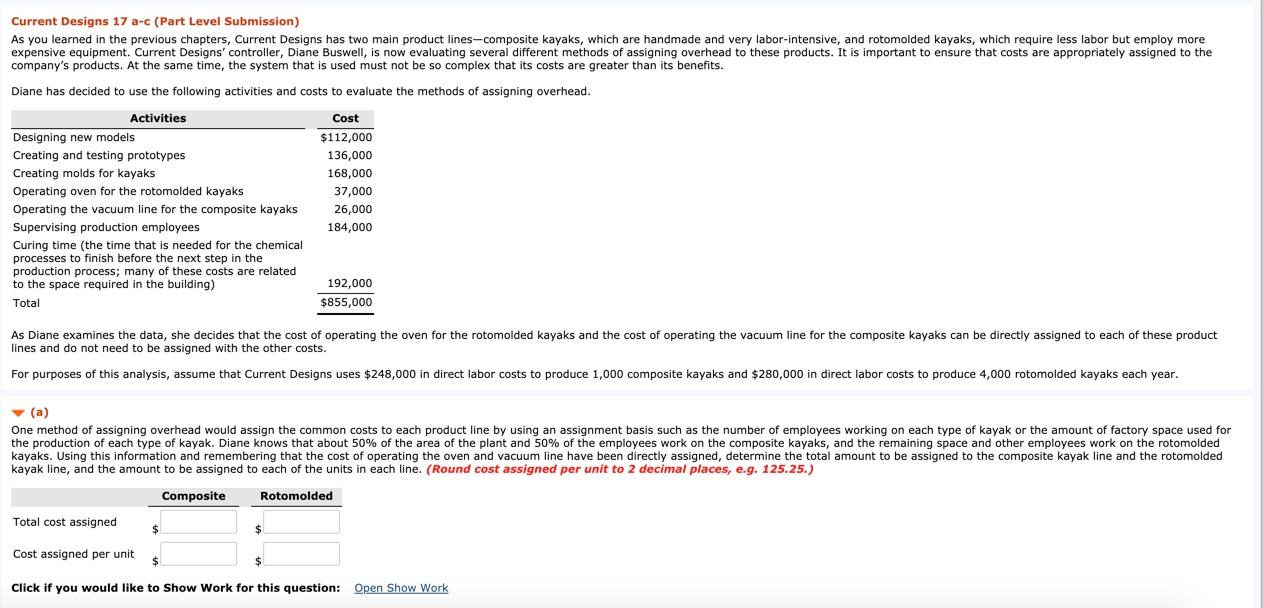


Current Designs 17 a-c (Part Level Submission) As you learned in the previous chapters, Current Designs has two main product lines-composite kayaks, which are handmade and very labor-intensive, and rotomolded kayaks, which require less labor but employ more expensive equipment. Current Designs' controller, Diane Buswell, is now evaluating several different methods of assigning overhead to these products. It is important to ensure that costs are appropriately assigned to the company's products. At the same time, the system that is used must not be so complex that its costs are greater than its benefits. Diane has decided to use the following activities and costs to evaluate the methods of assigning overhead. Activities Designing new models Creating and testing prototypes Creating molds for kayaks Operating oven for the rotomolded kayaks Operating the vacuum line for the composite kayaks Supervising production employees Curing time (the time that is needed for the chemical processes to finish before the next step in the production process; many of these costs are related to the space required in the building) Total Cost $112,000 136,000 168,000 37,000 26,000 184,000 192,000 $855,000 As Diane examines the data, she decides that the cost of operating the oven for the rotomolded kayaks and the cost of operating the vacuum line for the composite kayaks can be directly assigned to each of these product lines and do not need to be assigned with the other costs. For purposes of this analysis, assume that Current Designs uses $248,000 in direct labor costs to produce 1,000 composite kayaks and $280,000 in direct labor costs to produce 4,000 rotomolded kayaks each year. (a) One method of assigning overhead would assign the common costs to each product line by using an assignment basis such as the number of employees working on each type of kayak or the amount of factory space used for the production of each type of kayak. Diane knows that about 50% of the area of the plant and 50% of the employees work on the composite kayaks, and the remaining space and other employees work on the rotomolded kayaks. Using this information and remembering that the cost of operating the oven and vacuum line have been directly assigned, determine the total amount to be assigned to the composite kayak line and the rotomolded kayak line, and the amount to be assigned to each of the units in each line. (Round cost assigned per unit to 2 decimal places, e.g. 125.25.) Composite Rotomolded Total cost assigned $ Cost assigned per unit Click if you would like to Show Work for this question: Open Show Work Challenge Exercise 17-01 a-d2 (Part Level Submission) Waterway, Inc. produces two types of gas grills: a family model and a deluxe model. Waterway's controller has decided to use a plantwide overhead rate based on direct labor costs. The president of the company recently heard of activity-based costing and wants to see how the results would differ if this system were used. Two activity cost pools were developed: machining and machine setup. Presented below is information related to the company's operations: Direct labor costs Machine hours Setup hours Family Model $74,400 2,000 200 Deluxe Model $148,800 2,000 800 Total estimated overhead costs are $446,400. Overhead cost allocated to the machining activity cost pool is $267,840 and $178,560 is allocated to the machine setup activity cost pool. (a) Compute the overhead rate using the traditional (plantwide) approach. (Round answer to 2 decimal places, e.g. 15.25.) Overhead rate Click if you would like to Show Work for this question: Open Show Work Current Designs Problem 18 a-e (Part Level Submission) Bill Johnson, sales manager, and Diane Buswell, controller, at Current Designs are beginning to analyze the cost considerations for one of the composite models of the kayak division. They have provided the following production and operational costs necessary to produce one composite kayak. Kevlar $290 per kayak Resin and supplies $110 per kayak Finishing kit (seat, rudder, ropes, etc.) $150 per kayak Labor $440 per kayak Selling and administrative expenses-variable $460 per kayak Selling and administrative expenses-fixed $166,250 per year Manufacturing overhead-fixed $280,000 per year Bill and Diane have asked you to provide a cost-volume-profit analysis, to help them finalize the budget projections for the upcoming year. Bill has informed you that the selling price of the composite kayak will be $2,300. (a) Calculate variable costs per unit. Variable costs per unit $ Click if you would like to Show Work for this question: Open Show Work LINK TO TEXT LINK TO TEXT LINK TO TEXT









